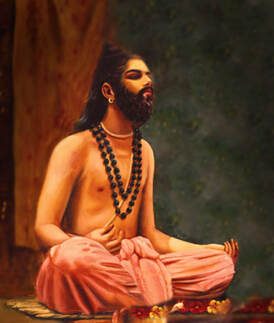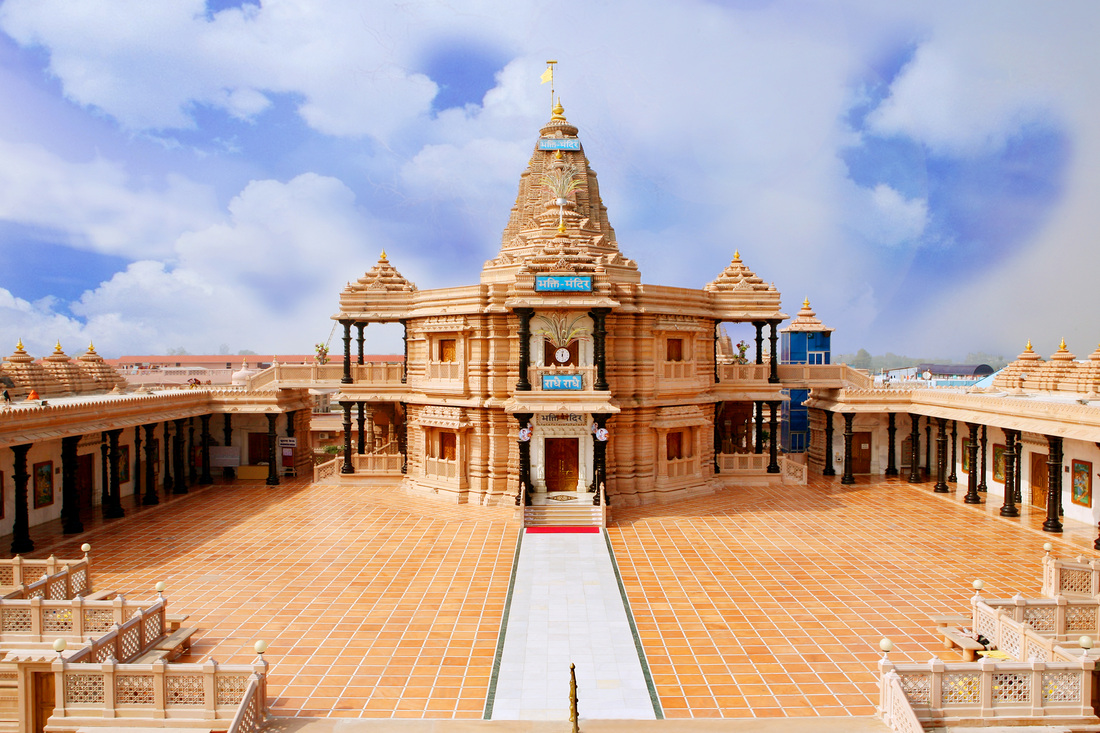 The first step for the Gyanis is to be Sadhan-Chatushtaya
The first step for the Gyanis is to be Sadhan-Chatushtaya
Question:
We have been told that the mind and intellect are material entities while the atma is Divine. We are also told that no material mind can ever comprehend the divine. So, how does the gyani comprehend the divine atma with a material mind?
Answer
Those who follow the path of Gyan (knowledge) are called gyanis. Before God realization a gyani is able to reach an intermediate state where he can realize the atma or the soul (or self). It is also a universally accepted fact that the atma is divine and is not comprehensible by a material mind or intellect. In this intermediate state, a gyani is still under the control of Maya and possesses a material mind. Then how does a gyani attain the realization himself to be the soul?
Our Vedic Hindu scriptures say that "I" is an epithet for the soul.
We have been told that the mind and intellect are material entities while the atma is Divine. We are also told that no material mind can ever comprehend the divine. So, how does the gyani comprehend the divine atma with a material mind?
Answer
Those who follow the path of Gyan (knowledge) are called gyanis. Before God realization a gyani is able to reach an intermediate state where he can realize the atma or the soul (or self). It is also a universally accepted fact that the atma is divine and is not comprehensible by a material mind or intellect. In this intermediate state, a gyani is still under the control of Maya and possesses a material mind. Then how does a gyani attain the realization himself to be the soul?
Our Vedic Hindu scriptures say that "I" is an epithet for the soul.
The soul is divine, eternal and cannot be destroyed. It is an inseparable part of the Brahm - Supreme God, who is an infinite ocean of Bliss. We have also heard that "the body is mine." According to Grammar (and also logic) whatsoever is "mine" cannot be "me" e.g. we say my house, my car, my wife etc; that means house, car, wife etc are different from me. Yet, we don't differentiate between me and mine when it comes to soul and body. However, we are inclined to believe that “I am the body."
The root cause of this ignorance is Maya. If one overcomes Maya, this ignorance will cease to exist. That is why gyanis aim to attain freedom from the clutches of Maya.
To overcome Maya, the first step for the gyani is to be Sadhan-Chatushtaya (साधनचतुष्टय), i.e. master the following four concepts:
After accomplishing these four concepts the gyani continuously chants the Vedic mantra:
The root cause of this ignorance is Maya. If one overcomes Maya, this ignorance will cease to exist. That is why gyanis aim to attain freedom from the clutches of Maya.
To overcome Maya, the first step for the gyani is to be Sadhan-Chatushtaya (साधनचतुष्टय), i.e. master the following four concepts:
- Nitya-Vastu-Vivekah (नित्यानित्यवस्तुविवेक) - attain the knowledge of the temporary and permanent entities in this world.
- Ihamuttra-phal-bhog-parityagah (इहामुत्रफलभोग परित्यागः) - relinquish the desire for acquiring anything (including luxuries) of this Earth or the celestial abodes.
- Sham-adi-shat-sampattih (शमादिषट्सम्पत्ति) - master the six important skills such as controlling the mind, controlling the senses etc.
- Moksha (मोक्ष) - develop such an intense desire for liberation from clutches of Maya that physical needs and dangers would seem trivial.
After accomplishing these four concepts the gyani continuously chants the Vedic mantra:
तत्त्वम्असि
tat tvam asi
tat tvam asi
"You are Him."
With constant contemplation of this mantra over a span of many lifetimes, a gyani’s mind develops this deep-rooted faith, that there is no difference between the soul (referred to as “You” in the shloka above) and God (referred to as “Him”).
But this mantra differentiates between “Him” (God) and “You” (soul). So somewhere in his mind, he is not truly convinced of the unity between “Him” and “You”. So, to remove this differentiation as well, gyani starts practicing:
With constant contemplation of this mantra over a span of many lifetimes, a gyani’s mind develops this deep-rooted faith, that there is no difference between the soul (referred to as “You” in the shloka above) and God (referred to as “Him”).
But this mantra differentiates between “Him” (God) and “You” (soul). So somewhere in his mind, he is not truly convinced of the unity between “Him” and “You”. So, to remove this differentiation as well, gyani starts practicing:
अहंब्रह्मास्मि
ahaṃ Brahmaāsmi
ahaṃ Brahmaāsmi
"I am Brahm" or in other words I (the soul) is non-different from the Supreme God.
According to the gyanis the belief that "I am a part of the Supreme God" is an illusion. They believe that there is only one entity called Brahm. They say:
According to the gyanis the belief that "I am a part of the Supreme God" is an illusion. They believe that there is only one entity called Brahm. They say:
एको ब्रह्म द्वितीयो नास्ति
eko brahma dvitīyo nāsti
eko brahma dvitīyo nāsti
"All that exists is Brahm. There is no entity other than Brahm.'' According to them, Jeev, or Maya are non-existent. Through constant practice of many lifetimes the gyani is convinced of non-duality.
After mastering this concept, he reaches the stage of Samadhi, in which his meditation becomes so deep that he forgets about the self. Hence instead of saying “Aham Brahmaasmi” he just feels Brahm, Brahm, Brahm.
Thus, he forgets about:
The triputi (त्रिपुटी) three aspects of Gyata, Gyan, Gyey (ज्ञाता, ज्ञान, ज्ञेय) merge into the self. This is called Niranjan Gyan. It is a very high stage of Gyan, where the aspirant conquers Rajas and Tamas guna of Maya. These two parts of Maya are together called Swaroopavarika Maya.
After mastering this concept, he reaches the stage of Samadhi, in which his meditation becomes so deep that he forgets about the self. Hence instead of saying “Aham Brahmaasmi” he just feels Brahm, Brahm, Brahm.
Thus, he forgets about:
- Gyata (ज्ञाता) – the self (seeker who wishes to know),
- Gyan (ज्ञान) – the knowledge and
- Gyey (ज्ञेय) – the one who needs to be known i.e. the object of knowledge
The triputi (त्रिपुटी) three aspects of Gyata, Gyan, Gyey (ज्ञाता, ज्ञान, ज्ञेय) merge into the self. This is called Niranjan Gyan. It is a very high stage of Gyan, where the aspirant conquers Rajas and Tamas guna of Maya. These two parts of Maya are together called Swaroopavarika Maya.
|
Swaroopavarika Maya is responsible for covering the true identity of the Jeev. The loss of the true identity creates an illusion which makes the living being believe that what should be mine (body) is me (1). When the Swaroopavarika Maya is gone the illusion of "I am the body", is gone. It is also called Atma-Gyan or acknowledgement of the soul. At this state, the aspirant becomes entirely free from all physical afflictions. This state of a gyani is known as Brahma Bhootavastha (ब्रह्मभूतावस्था) and the gyani is now called Atma gyani.
ब्रह्मभूतः प्रसन्नात्मा न शोचति न कांक्षति। समः सर्वेषुभूतेषु मद्भक्तिं लभते पराम्॥
गीता १८ ५४
Brahmaabhūtaḥ prasannātmā na śocati na kāṃkṣati।
samaḥ sarveṣubhūteṣu madbhaktiṃ labhate parām ॥ Gītā 18.54
"A gyani is ever happy. He does not get upset with anything, nor does he desire for anything. He is completely self-satisfied and always at peace. He does not discriminate between any living being. Now the gyani is ready to practice devotion.”
A question may arise, when a gyani is always happy, what is the need of practicing devotion? Because, as I mentioned earlier, he is absolved from two thirds of Maya i.e. Rajas and Tamas mode of Maya, but he is still under the influence of Sattvic mode of Maya. |
Because,
सत्वाद् संजायते ज्ञानम्
satvād saṃjāyate jñānam
satvād saṃjāyate jñānam
“Knowledge rises from the sattva mode”; So far, due to lack of knowledge, he considered the body to be the real “I”;. But, after the emergence of knowledge, the clouds of ignorance get dissolved and the individual realizes himself to be the atma. Hence, Atma-Gyan means realization of the self.
So, it has been clarified that the material intellect does not realize atma. Since the mind and intellect (aka Gyata) cease to exist, it gives rise to the realization of atma.
So, it has been clarified that the material intellect does not realize atma. Since the mind and intellect (aka Gyata) cease to exist, it gives rise to the realization of atma.
It is to be noted that self-realization is not the same as God realization. God realization happens after the gyani overcomes Sattvguni Maya (or Gunavarika Maya). Even though the gyani wants to merge in the impersonal form of God (Nirakaar Brahma), yet he has to worship the personal form (Sagun-Saakaar Brahm) of God, i.e. do bhakti.
Nirakaar Brahma exhibits only two attributes;
Also, no one can overcome Maya on their own. As Shri Krishna says in Gita -
Nirakaar Brahma exhibits only two attributes;
- maintains its identity and
- remains ever blissful
Also, no one can overcome Maya on their own. As Shri Krishna says in Gita -
दैवी ह्येषा गुणमयी मम माया दुरत्यया ॥
daivī hyeṣā guṇamayī mama māyā duratyayā, māmeva ye prapadyante māyāmetāṁ taranti te
daivī hyeṣā guṇamayī mama māyā duratyayā, māmeva ye prapadyante māyāmetāṁ taranti te
“This Maya, which is Mine, consists of the three gunas and no-one can overcome it on their own. Only those, who are fully surrendered to Me are able to cross this ocean of Maya, by My grace.”
In conclusion, only when Sagun-Saakaar-Brahm (the personal form of God) graces the gyani by removing the veil of Maya does the gyani attain Nirakaar Brahma (the impersonal form of God) and become Brahma-gyani aka knower-of-God.
In conclusion, only when Sagun-Saakaar-Brahm (the personal form of God) graces the gyani by removing the veil of Maya does the gyani attain Nirakaar Brahma (the impersonal form of God) and become Brahma-gyani aka knower-of-God.




